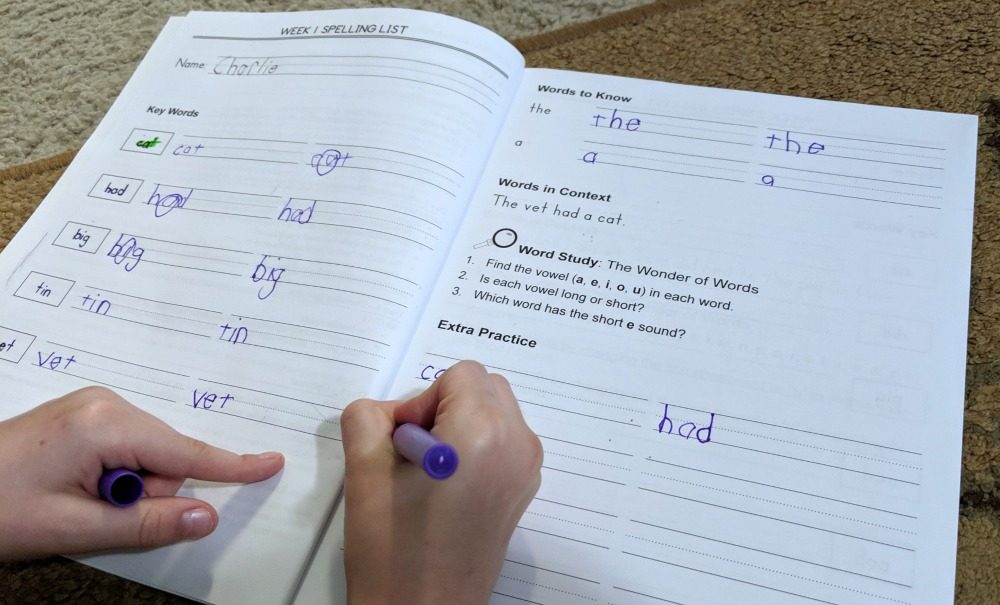I have been wondering how to begin spelling instruction with my son, who is just now completing first grade. What perfect timing for us to receive Simply Classical Spelling Book One: Step-by-Step Words and Simply Classical Spelling Book Two: Step-by-Step Words, written by Cheryl Swope, from Memoria Press.

Book one is meant to be used with children that are ages 6-8, or who are at around that skill level. It is actually a special needs program, using a multi-sensory approach to properly teach and help your child retain spelling words. The second book is meant to immediately follow the first. If you have an elementary school student struggling with spelling, read on to see how Memoria Press has designed this curriculum to cater to your special learner!

Let me start out by saying that my son has never been diagnosed with ADHD, but my dad has been a child psychologist for over 30 years and has often asked me if I’m ever going to have him tested. We all kind of know that he fits the profile, but I think my dad is wondering what his IQ is and is chomping at the bit to test him. 🙂 Since we homeschool, I’ve not really worried about getting a diagnosis and we just do our schooling around his attention span and teach him in ways that excite him so he can’t help but engage.
Simply Classical Spelling Book One: Step-by-Step Words
This spelling program fits this need well, because it uses multiple approaches to teach the weekly lists.
Before you begin this book, be sure they are ready. If your child isn’t able to spell words from the easier short-vowel families (like mat, rat, at, sat) with at least 80% accuracy, the book Classical Phonics would be a better place to start.
We have been using Simply Classical Spelling Book One over the past several weeks. In this book, there are 34 weeks of lessons, including 3 weeks that are review spelling lists and a mixed test for week 34.

The Teacher Notes in the book are extremely informative on training the mind to spell well, and how to work on this word by word. It talks about how to teach words that follow rules, as well as important exceptions to those rules.
The method encourages students to read, remember, and recite. They are being taught to use words in context, study words and analyze things about them, and then have the opportunity for extra practice each week.
Without giving away the entire system, it goes something like this:
Day 1 – Memorize (Read)
Students will read the words, say the word, spell it out loud rhythmically, and read it in context.
Day 2 – Hands-on Touch (Remember)
Students read the list, say and spell it out loud rhythmically, talk about patterns in the words and trace them, and there are optional activities to further go over the list in a more tactile way.
Day 3 – Write High (Remember)
Students read the list, say it out loud and spell it orally, picture the word in their mind, use letter cards to spell their weekly list of words, and “write” the word in the air (or on paper if they like, which is what my son chose to do on these days). Again, there are optional activities to further enrich their spelling studies for a more hands-on approach.
Day 4 – Quiz (Recite)
On this day, the student will stand up and when the teacher tells them a word from the list, they are to say the word, spell it, and say it again. They are to do this for the whole list, but there are instructions about how and when to correct students when they make errors.
Day 5 (Review)
This is an optional day where kids are able to look at the correct spelling of words, copy them with letter cards, writing them, or using tiles or beads, and then reciting them orally again.

We have enjoyed this approach to spelling. Charlie has never spelled things out loud, from memory before. He had a difficult time the first 2 weeks on the program, but he’s gotten the hang of it now. He prefers to write in the actual book rather than use a dry erase board or letter tiles or another method, but I told him that as the words get more and more complex, he might prefer to use multiple methods to practice because it gives different opportunities to master the words before moving on.
We have been using it 5 days a week, and there has been no struggle at all. The lessons are quite brief. As with other Memoria Press materials, the lessons are structured the same each week, so there is a specific rhythm and flow to using the program that really helps my son to know what he’s going to be doing in spelling each day. It really reduces any kind of push-back, because he knows the lessons will be short and to the point, and he knows the pattern of how we do things now. He’s been bringing me his spelling book to work on every morning and I’ve had no complaints from him at all! That’s a huge win for us.
Simply Classical Spelling Book Two: Step-by-Step Words
Once your child has completed the first book, Simply Classical Spelling Book Two: Step-by-Step Words is available. This book is more complex as it introduces more challenging words, multi-syllabic words, and more complicated combinations of phonograms. This book uses these steps after studying their words during the week:
1. Write letters that represent specific sounds.
2. Write individual words that are comprised by them.
3. Write a full sentence using these words. Use written and oral processes to learn to connect spelling with accurate writing and reading.
There is a pre-test on page 5 of the book to have students complete prior to beginning this program. You are to administer it again at the end of the year as a post-test and show your student how much they have mastered during the school year! However, if your student was able to complete the pre-test with at least 90% accuracy, they will need a more challenging program. This is a good way to know if the program is advanced enough for your special learner this school year.
Book Two has longer, more involved lessons that the first book. The great thing about it, though, is that it is encouraging students to use flashcards more, incorporate games, and do extra review to make sure they’re really getting those words.
The set up of the day in Book Two is:
Monday – Memorize
Tuesday – Tracing
Wednesday – Word Study and Write High
Thursday – Quiz
Friday – Dictation
There are 34 weeks of instruction in this book as well, including 8 different assessments. The back of the book has weekly dictations for each week’s assignments. It also has the words to read out for their assessments and a place to write down how many total correct were scored.
Both books contain a Scope & Sequence at the back of the book, which includes a week-by-week breakdown of the keywords’ phonics/spelling pattern or rule and which words they are being taught and tested on.There is also a summary, as well as common words and sight words as “words to know.”
Book Two has a Certificate of Merit that you can present to your child once they finish the program, too!
Our family has enjoyed using this Memoria Press program. I am now confidently teaching my 7 year old to spell, and he is thriving! I was worried it would be so hard since he has a short attention span, but it’s going better than I could have hoped.
This program would work well for any elementary students who need a little extra help when it comes to spelling. If your child is not a “natural speller” and they struggle with other programs because the words just don’t stick, this approach may be just what they need to be a better speller, reader, and writer.
The Homeschool Review Crew reviewed several different Memoria Press programs. Click the banner below to find out which ones and how their families enjoyed them:



